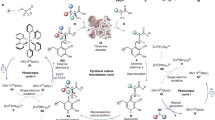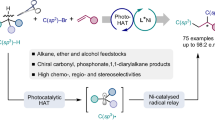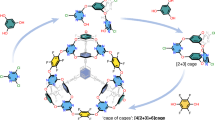Abstract
Glycosylated natural products and synthetic glycopeptides represent a significant and growing source of biochemical probes and therapeutic agents. However, methods that enable the aqueous glycosylation of endogenous amino acid functionality in peptides without the use of protecting groups are scarce. Here, we report a transformation that facilitates the efficient aqueous O-glycosylation of phenolic functionality in a wide range of small molecules, unprotected tyrosine, and tyrosine residues embedded within a range of complex, fully unprotected peptides. The transformation, which uses glycosyl fluoride donors and is promoted by Ca(OH)2, proceeds rapidly at room temperature in water, with good yields and selective formation of unique anomeric products depending on the stereochemistry of the glycosyl donor. High functional group tolerance is observed, and the phenol glycosylation occurs selectively in the presence of virtually all side chains of the proteinogenic amino acids with the singular exception of Cys. This method offers a highly selective, efficient, and operationally simple approach for the protecting-group-free synthesis of O-aryl glycosides and Tyr-O-glycosylated peptides in water.
This is a preview of subscription content, access via your institution
Access options
Access Nature and 54 other Nature Portfolio journals
Get Nature+, our best-value online-access subscription
$29.99 / 30 days
cancel any time
Subscribe to this journal
Receive 12 print issues and online access
$259.00 per year
only $21.58 per issue
Buy this article
- Purchase on Springer Link
- Instant access to full article PDF
Prices may be subject to local taxes which are calculated during checkout





Similar content being viewed by others
References
Bednarska, N. G., Wren, B. W. & Willcocks, S. J. The importance of the glycosylation of antimicrobial peptides: natural and synthetic approaches. Drug Discov. Today 22, 919–926 (2017).
Varamini, P. et al. Synthesis and biological evaluation of an orally active glycosylated endomorphin-1. J. Med. Chem. 55, 5859–5867 (2012).
Polt, R., Dhanasekaran, M. & Keyari, C. M. Glycosylated neuropeptides: a new vista for neuropsychopharmacology? Med. Res. Rev. 25, 557–585 (2005).
Ho, H. H., Gilbert, M. T., Nussenzveig, D. R. & Gershengorn, M. C. Glycosylation is important for binding to human calcitonin receptors. Biochemistry 38, 1866–1872 (1999).
Herzner, H., Reipen, T., Schultz, M. & Kunz, H. Synthesis of glycopeptides containing carbohydrate and peptide recognition motifs. Chem. Rev. 100, 4495–4538 (2000).
Moradi, S. V., Hussein, W. M., Varamini, P., Simerska, P. & Toth, I. Glycosylation, an effective synthetic strategy to improve the bioavailability of therapeutic peptides. Chem. Sci. 7, 2492–2500 (2016).
Paradís-Bas, M., Tulla-Puche, J. & Albericio, F. The road to the synthesis of ‘difficult peptides’. Chem. Soc. Rev. 45, 631–654 (2016).
Westerlind, U. Synthetic glycopeptides and glycoproteins with applications in biological research. Beilstein J. Org. Chem. 8, 804–818 (2012).
Pratt, M. R. & Bertozzi, C. R. Synthetic glycopeptides and glycoproteins as tools for biology. Chem. Soc. Rev. 34, 58–68 (2005).
Seitz, O. Glycopeptide synthesis and the effects of glycosylation on protein structure and activity. ChemBioChem 1, 214–246 (2000).
Downey, A. M. & Hocek, M. Strategies toward protecting group-free glycosylation through selective activation of the anomeric center. Beilstein J. Org. Chem. 13, 1239–1279 (2017).
Taylor, M. S. Catalyst-controlled, regioselective reactions of carbohydrate derivatives. Top. Curr. Chem. 372, 125–155 (2016).
Lee, D. & Taylor, M. S. Catalyst-controlled regioselective reactions of carbohydrate derivatives. Synthesis 44, 3421–3431 (2012).
Wang, L.-X. & Amin, M. N. Chemical and chemoenzymatic synthesis of glycoproteins for deciphering functions. Chem. Biol. 21, 51–66 (2014).
Nakayama, A. et al. Enzymatic glycosylation of vancomycin aglycon: completion of a total synthesis of vancomycin and N- and C-terminus substituent effects of the aglycon substrate. Org. Lett. 16, 3572–3575 (2014).
Li, T.-L., Liu, Y.-C. & Lyu, S.-Y. Combining biocatalysis and chemoselective chemistries for glycopeptide antibiotics modification. Curr. Opin. Chem. Biol. 16, 170–178 (2012).
Zhang, C. et al. Exploiting the reversibility of natural product glycosyltransferase-catalyzed reactions. Science 313, 1291–1294 (2006).
Demchenko, A. V. Handbook of Chemical Glycosylation: Advances in Stereoselectivity and Therapeutic Relevance (Wiley-VCH, Weinheim, 2008).
deGruyter, J. N., Malins, L. R. & Baran, P. S. Residue-specific peptide modification: a chemist's guide. Biochemistry 56, 3863–3873 (2017).
Gunnoo, S. B. & Madder, A. Bioconjugation—using selective chemistry to enhance the properties of proteins and peptides as therapeutics and carriers. Org. Biomol. Chem. 14, 8002–8013 (2016).
Koniev, O. & Wagner, A. Developments and recent advancements in the field of endogenous amino acid selective bond forming reactions for bioconjugation. Chem. Soc. Rev. 44, 5495–5551 (2015).
Boutureira, O. & Bernardes, G. J. L. Advances in chemical protein modification. Chem. Rev. 115, 2174–2195 (2015).
Gamblin, D. P., Scanlan, E. M. & Davis, B. G. Glycoprotein synthesis: an update. Chem. Rev. 109, 131–163 (2009).
Davis, B. G. Synthesis of glycoproteins. Chem. Rev. 102, 579–602 (2002).
Lamandé-Langle, S. et al. ‘Click’ glycosylation of peptides through cysteine propargylation and CuAAC. Bioorg. Med. Chem. 22, 6672–6683 (2014).
Dondoni, A. & Marra, A. Recent applications of thiol-ene coupling as a click process for glycoconjugation. Chem. Soc. Rev. 41, 573–586 (2012).
Fernandez-Gonzalez, M. et al. Site-selective chemoenzymatic construction of synthetic glycoproteins using endoglycosidases. Chem. Sci. 1, 709–715 (2010).
Bernardes, G. J. L. et al. From disulfide- to thioether-linked glycoproteins. Angew. Chem. Int. Ed. 47, 2244–2247 (2008).
Krauss, I. J. et al. Fully synthetic carbohydrate HIV antigens designed on the logic of the 2G12 antibody. J. Am. Chem. Soc. 129, 11042–11044 (2007).
Mu, J. & Roach, P. J. Characterization of human glycogenin-2, a self-glucosylating initiator of liver glycogen metabolism. J. Biol. Chem. 273, 34850–34856 (1998).
Zarschler, K. et al. Protein tyrosine O-glycosylation—a rather unexplored prokaryotic glycosylation system. Glycobiology 20, 787–798 (2010).
Halim, A. et al. Site-specific characterization of threonine, serine, and tyrosine glycosylations of amyloid precursor protein/amyloid β-peptides in human cerebrospinal fluid. Proc. Natl Acad. Sci. USA 108, 11848–11853 (2011).
Lafite, P. & Daniellou, R. Rare and unusual glycosylation of peptides and proteins. Nat. Prod. Rep. 29, 729–738 (2012).
Wang, P., Nilsson, J., Brinkmalm, G., Larson, G. & Huang, X. Synthesis aided structural determination of amyloid-β(1–15) glycopeptides, new biomarkers for Alzheimer's disease. Chem. Commun. 50, 15067–15070 (2014).
Fichna, J. et al. Novel glycosylated endomorphin-2 analog produces potent centrally-mediated antinociception in mice after peripheral administration. Bioorg. Med. Chem. Lett. 23, 6673–6676 (2013).
Jansson, A. M. et al. Solid-phase glycopeptide synthesis of tyrosine-glycosylated glycogenin fragments as substrates for glucosylation by glycogenin. J. Chem. Soc., Perkin Trans. 1, 1001–1006 (1996).
Fahmi, N. E., Dedkova, L., Wang, B., Golovine, S. & Hecht, S. M. Site-specific incorporation of glycosylated serine and tyrosine derivatives into proteins. J. Am. Chem. Soc. 129, 3586–3597 (2007).
Michael, A. On the synthesis of helicon and phenolglucoside. Am. Chem. J. 1, 305–312 (1879).
Brito-Arias, M. Synthesis and Characterization of Glycosides 81–168 (Springer International, Cham, 2016).
Capicciotti, C. J. et al. O-Aryl-glycoside ice recrystallization inhibitors as novel cryoprotectants: a structure–function study. ACS Omega 1, 656–662 (2016).
Henderson, A. S., Medina, S., Bower, J. F. & Galan, M. C. Nucleophilic aromatic substitution (SNAr) as an approach to challenging carbohydrate–aryl ethers. Org. Lett. 17, 4846–4849 (2015).
Li, Y., Mo, H., Lian, G. & Yu, B. Revisit of the phenol O-glycosylation with glycosyl imidates, BF3·OEt2 is a better catalyst than TMSOTf. Carbohydr. Res. 363, 14–22 (2012).
Jacobsson, M., Malmberg, J. & Ellervik, U. Aromatic O-glycosylation. Carbohydr. Res. 341, 1266–1281 (2006).
Jensen, K. J. O-Glycosylations under neutral or basic conditions. J. Chem. Soc., Perkin Trans. 1, 2219–2233 (2002).
Park, Y. et al. Macrocyclic bis-thioureas catalyze stereospecific glycosylation reactions. Science 355, 162–166 (2017).
Hahm, H. S. et al. Automated glycan assembly of complex oligosaccharides related to blood group determinants. J. Org. Chem. 81, 5866–5877 (2016).
Mydock, L. K. & Demchenko, A. V. Mechanism of chemical O-glycosylation: from early studies to recent discoveries. Org. Biomol. Chem. 8, 497–510 (2010).
Nicolaou, K. C. & Mitchell, H. J. Adventures in carbohydrate chemistry: new synthetic technologies, chemical synthesis, molecular design, and chemical biology. Angew. Chem. Int. Ed. 40, 1576–1624 (2001).
Toshima, K. Glycosyl fluorides in glycosidations. Carbohydr. Res. 327, 15–26 (2000).
Shimizu, M., Togo, H. & Yokoyama, M. Chemistry of glycosyl fluorides. Synthesis 1998, 799–822 (1998).
Willems, L. I. et al. From covalent glycosidase inhibitors to activity-based glycosidase probes. Chem. Eur. J. 20, 10864–10872 (2014).
Rempel, B. P. & Withers, S. G. Covalent inhibitors of glycosidases and their applications in biochemistry and biology. Glycobiology 18, 570–586 (2008).
Evans, M. J. & Cravatt, B. F. Mechanism-based profiling of enzyme families. Chem. Rev. 106, 3279–3301 (2006).
Banait, N. S. & Jencks, W. P. Reactions of anionic nucleophiles with α-d-glucopyranosyl fluoride in aqueous solution through a concerted, ANDN (SN2) mechanism. J. Am. Chem. Soc. 113, 7951–7958 (1991).
Banait, N. S. & Jencks, W. P. General-acid and general-base catalysis of the cleavage of α-d-glucopyranosyl fluoride. J. Am. Chem. Soc. 113, 7958–7963 (1991).
Pelletier, G., Zwicker, A., Allen, C. L., Schepartz, A. & Miller, S. J. Aqueous glycosylation of unprotected sucrose employing glycosyl fluorides in the presence of calcium ion and trimethylamine. J. Am. Chem. Soc. 138, 3175–3182 (2016).
Bohé, L. & Crich, D. A propos of glycosyl cations and the mechanism of chemical glycosylation; the current state of the art. Carbohydr. Res. 403, 48–59 (2015).
Chan, J., Sannikova, N., Tang, A. & Bennet, A. J. Transition-state structure for the quintessential SN2 reaction of a carbohydrate: reaction of α-glucopyranosyl fluoride with azide ion in water. J. Am. Chem. Soc. 136, 12225–12228 (2014).
Stubbs, J. M. & Marx, D. Glycosidic bond formation in aqueous solution: on the oxocarbenium intermediate. J. Am. Chem. Soc. 125, 10960–10962 (2003).
Micheel, F. & Klemer, A. Über den Reaktionsmechanismus der Glycosidbildung aus α- und β-1-Fluor-Derivaten der d-Glucose und d-Mannose. Chem. Ber. 91, 663–667 (1958).
Halcomb, R. L. & Danishefsky, S. J. On the direct epoxidation of glycals: application of a reiterative strategy for the synthesis of β-linked oligosaccharides. J. Am. Chem. Soc. 111, 6661–6666 (1989).
Underwood, C. R. et al. Crystal structure of glucagon-like peptide-1 in complex with the extracellular domain of the glucagon-like peptide-1 receptor. J. Biol. Chem. 285, 723–730 (2010).
Kieffer, T. J. & Habener, J. F. The glucagon-like peptides. Endocrin. Rev. 20, 876–913 (1999).
Zadina, J. E. et al. Endomorphins: novel endogenous μ-opiate receptor agonists in regions of high μ-opiate receptor density. Ann. NY Acad. Sci. 897, 136–144 (1999).
Podlogar, B. L. et al. Conformational analysis of the endogenous μ-opioid agonist endomorphin-1 using NMR spectroscopy and molecular modeling. FEBS Lett. 439, 13–20 (1998).
Noda, M. et al. Isolation and structural organization of the human preproenkephalin gene. Nature 297, 431–434 (1982).
Burgus, R. et al. Primary structure of the ovine hypothalamic luteinizing hormone-releasing factor (LRF). Proc. Natl Acad. Sci. USA 69, 278–282 (1972).
Donaldson, Z. R. & Young, L. J. Oxytocin, vasopressin, and the neurogenetics of sociality. Science 322, 900–904 (2008).
Austin, L. A. & Heath, H. 3rd Calcitonin physiology and pathophysiology. N. Engl. J. Med. 304, 269–278 (1981).
Haynes, W. M. (ed.) CRC Handbook of Chemistry and Physics 97th edn (CRC/Taylor & Francis, Boca Raton, 2017); http://hbcponline.com/faces/contents/ContentsSearch.xhtml
Lian, G., Zhang, X. & Yu, B. Thioglycosides in carbohydrate research. Carbohydr. Res. 403, 13–22 (2015).
Brimble, M. A. et al. Synthesis of the antimicrobial S-linked glycopeptide, glycocin F. Chem. Eur. J. 21, 3556–3561 (2015).
Rojas-Ocáriz, V. et al. Design of α-S-neoglycopeptides derived from MUC1 with a flexible and solvent-exposed sugar moiety. J. Org. Chem. 81, 5929–5941 (2016).
Kahne, D., Walker, S., Cheng, Y. & Van Engen, D. Glycosylation of unreactive substrates. J. Am. Chem. Soc. 111, 6881–6882 (1989).
Acknowledgements
This work was initially supported by the W.M. Keck Foundation and later by the National Institutes of Health (NIH GM068649). The authors thank A. Zwicker for insightful discussions. A.St. was a Howard Hughes Medical Institute International Student Research fellow. G.P. is grateful to NSERC (PDF) and FQRNT (B3) for postgraduate fellowships. L.H. acknowledges support from an NIH postdoctoral fellowship (F32-GM-122204).
Author information
Authors and Affiliations
Contributions
T.J.W., A.St., G.P., A.Sch. and S.J.M. conceived and designed the study. G.P. performed initial experiments. T.J.W., A.St. and L.H. performed the synthetic experiments and analysed data for all compounds. T.J.W., A.St., L.H., G.P., A.Sch. and S.J.M. co-wrote the paper.
Corresponding authors
Ethics declarations
Competing interests
The authors declare no competing interests.
Additional information
Publisher’s note: Springer Nature remains neutral with regard to jurisdictional claims in published maps and institutional affiliations.
Supplementary information
Supplementary Information
Supplementary synthesis and characterization details, Supplementary Tables 1–5, and NMR spectra
Rights and permissions
About this article
Cite this article
Wadzinski, T.J., Steinauer, A., Hie, L. et al. Rapid phenolic O-glycosylation of small molecules and complex unprotected peptides in aqueous solvent. Nature Chem 10, 644–652 (2018). https://doi.org/10.1038/s41557-018-0041-8
Received:
Accepted:
Published:
Issue Date:
DOI: https://doi.org/10.1038/s41557-018-0041-8
This article is cited by
-
Parallel pathways for serotonin biosynthesis and metabolism in C. elegans
Nature Chemical Biology (2023)
-
Halogen-bond-assisted radical activation of glycosyl donors enables mild and stereoconvergent 1,2-cis-glycosylation
Nature Chemistry (2022)
-
Expanding chemical space by para-C−H arylation of arenes
Nature Communications (2022)
-
The glycosylation in SARS-CoV-2 and its receptor ACE2
Signal Transduction and Targeted Therapy (2021)
-
A glucotolerant β-glucosidase from the fungus Talaromyces amestolkiae and its conversion into a glycosynthase for glycosylation of phenolic compounds
Microbial Cell Factories (2020)



